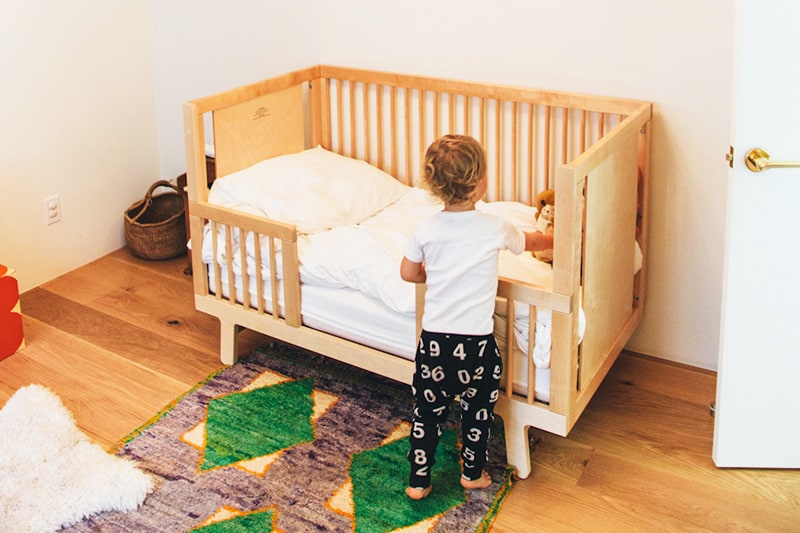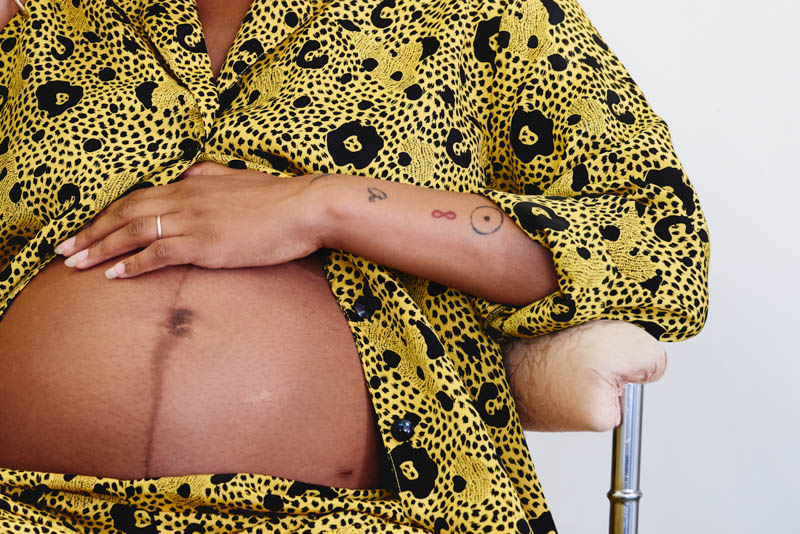
How To Make The Crib-To-Toddler Bed Transition
Written by Katie Hintz-Zambrano
Photography by Photographed by Paige Jones
Like many phases of parenthood, just when it’s getting a bit easy and you’re starting to get a grip on things, your child goes through yet another transition. And one of the bigger changes that happen during the toddler stage is your little one transitioning out of a crib and into a “big kid” bed. Brace yourselves mamas: This one’s quite the milestone, and can often make you feel like you’re back in the newborn days, with frequent waking spells and lots of co-sleeping. To help advise parents with kiddies in the terrible/terrific twos and threes that are going through or are about to go through this transition, we’ve tapped the “Sleep Sisters,” Debbie and Melissa Freidman, to answer our burning Q’s.
What are the signs that your child is ready to transition out of the crib?
“We believe that the later you start the transition, the better! Toddlers are tough all the time, and when there’s a major transition, they become even more challenging! The more independent they are, the better. They should be showing some signs of being able to manage their independence. That is to say, most toddlers struggle because they want to do things for themselves, but they cannot actually manage the physical demands. Toddlers who are further along in this development, however, are more ready to sleep in a bed. Look out for signs, like your child being able to dress themselves, put on their own shoes, and being able to communicate with you about their needs. Ideally, this transition does not happen before your child is potty training at night, usually around 3-years-old”
If your child is consistently crawling/trying to crawl out of his crib, what can you do?
“Crib tents are no longer considered safe, so we do not recommend use of anything that covers the crib. Instead, we would advise parents to keep their toddlers in a sleep sack—they make them for toddlers now! This way, he won’t be able to lift his leg over the side of the crib. If he’s persistent and unzips his sack to climb, and the situation is unsafe, we would have to recommend an early (and challenging) transition into a bed.”
Is there any conversation you should have with your child when transitioning to a toddler bed?
“Yes! 3-year-olds are absolutely able and ready to be a part of the conversation! We recommend having a ‘family meeting’ to talk about the importance of sleep (just like we need to eat healthy foods, we need healthy sleep to stay well and to grow big and strong) and the ‘family sleep expectations’! Visuals are a great tool to use with toddlers. Cut out pictures and make posters to put on the back of the toddler’s bedroom door and on the front of the parents’ door. We recommend talking about everyone sleeping in her own bed: ‘Mommy sleeps in her bed and you sleep in your bed. In the morning, when it’s light out, we will all start our day together!'”
Any first-night tips?
“Stick with the plan! This is tough. When it’s dark and quiet and you just want to sleep, getting up out of your warm bed to put your child back into his own bed seems like too much effort. It’s easier to let them crawl into bed with you, but resist the urge! Habits are formed in three days! Have a firm plan with your partner and make sure you’re clear about who will do what if the child gets out of bed. Make sure the child knows what to expect—no surprises! And then once it’s morning, we celebrate any success we had, even if it was small: ‘Hooray! You stayed in your bed after Mommy brought you back! Tonight, we’ll try again to have everyone stay in her own bed all night!'”
Now that your child has a new sense of freedom, how can you prevent them from popping out of their bed, opening their door, and refusing to go to bed?
“A lot of this is about preparation—for both parents and children. Everyone does better when they know the plan and there are clear expectations. We like using a stop light clock (see our blog about this!) to help teach toddlers about when it’s ok to wake. Once they know their colors, it’s a wonderful tool. A parent can tell his child, ‘Ok, we’ll see you when the green light comes on!’ And if the child wakes before the scheduled time, a parent can say, ‘Is your light green? No? Please go back to bed and we’ll see you when the green light comes on!’ For children who are really struggling, a baby gate on their bedroom door sometimes helps. We use this tool with many of our families who have children who are particularly willful. Debbie’s own toddler had a gate on her door for two years. She needed that visual limit set for her and many toddlers are the same. It also gives parents a sense of security knowing that their child is safely in their room.”
When your child consistently gets up in the middle of the night, what is the protocol?
“We try to prevent this scenario with good preparation of both the parents and children. Returning a child to bed with little or no interaction is usually our first step. Parents often struggle with this because it’s hard to not engage with a child and is usually easier just to lie down with her instead of doing the harder job of taking her quietly back to bed. With the ‘silent return to bed’ we really recommend very little contact. Take her hand, say, ‘It’s time for bed,’ and then silently return her to bed. No need to pat or tuck or sing! She may bounce right up and just walk to the door, turn around and do the same thing all over again. Some parents end up doing this all night for a few nights until the child understands that the parent really means business. It takes a lot of dedication for a week or two, but then you have the rest of your life to have an amazing sleeper (and get some sleep yourself, too!). We should also mention here that when we work with families we always stress the importance of a routine which will help establish a strong foundation for healthy sleep. We spend a great deal of time coming up with a plan that will work with each individual family’s needs. One size does not fit all! It’s important to assess what motivates an individual child and what might be the underlying cause of the sleep disturbance—whether before bed, nap, or in the middle of the night.”
How do you get your child to actually sleep in a toddler bed (without a parent sitting next to him)?
“The key is to establish healthy sleep expectations as soon as possible. As parents, one of our biggest roles is to help our children become independent. We teach them to use the bathroom on their own, to walk on their own, to get dressed….and by allowing them to establish independence, we are giving them a sense of agency. We are telling them, you are your own person and you are a capable human being. Sleep is no different. We want children to know that they can do this on their own because we won’t always be there with them. Children should sleep on their own and know that we have given them the skills they need to be successful on their own. When they get out of bed in the middle of the night, we need to remind them of this fact by not interfering and allowing them to do it without help!”
Any safety measures someone should take when setting up a toddler bed?
“Toddler beds are generally safe and fairly close the floor. Most toddlers feel more secure in a smaller bed. We don’t recommend transitioning right into a queen size bed, for example. It feels too vast and is generally much higher off the ground. Kids fall out of bed sometimes and that’s ok. If you use a safety rail, make sure it’s installed correctly and is an approved model! Most kids like having their bed up against a wall at first to give them an added sense of security. Of course, always transition your child with his favorite lovey and anything else that has been an attachment object in his crib. It call all move into the bed with him!”
For more on the Sleep Sisters and their approach to toddler sleep issues, click here and here.
Share this story



